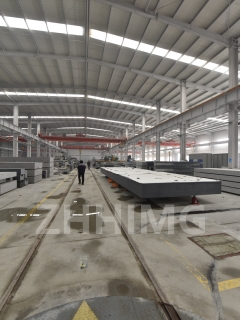In recent years, granite has become a popular material for manufacturing components in various industries, including aerospace, automotive, and medical. This is mainly due to its excellent properties such as high strength, durability, and resistance to wear and corrosion. However, in order to ensure that granite components perform to the best of their abilities, it is important to conduct testing to evaluate their performance. In this article, we will discuss how to evaluate the performance of granite components through testing, specifically using a bridge coordinate measuring machine (CMM).
Bridge CMMs are widely used in the manufacturing industry to accurately measure the dimensions and tolerances of parts in three-dimensional space. They work by using a touch probe to record the coordinates of points on the surface of the part being measured. This data is then used to create a 3D model of the component, which can be analyzed to determine if it meets the required specifications.
When testing granite components, CMMs can be used to measure various parameters such as the dimensions, flatness, and surface finish of the part. These measurements can then be compared to the expected values, which are typically provided in the part’s design specifications. If there is a significant deviation from these values, it may indicate that the part is not performing as intended.
In addition to traditional CMM measurements, there are other testing methods that can be used to evaluate the performance of granite components. These include:
1. Hardness testing: This involves measuring the hardness of the granite to determine if it is suitable for the intended application. Hardness tests can be carried out using a Mohs scale or a Vickers hardness tester.
2. Tensile testing: This involves applying a controlled force to the part to measure its strength and elasticity. This is particularly important for parts that will be subjected to high stress or strain.
3. Impact testing: This involves subjecting the part to a sudden impact to determine its resistance to shock and vibration. This is particularly important for parts that will be used in applications where they may be exposed to sudden impacts or vibrations.
4. Corrosion testing: This involves exposing the part to various corrosive agents to determine its resistance to corrosion. This is particularly important for parts that will be used in applications where they may be exposed to corrosive substances.
By conducting these tests, manufacturers can ensure that their granite components are performing to the best of their abilities and are suitable for the intended application. This not only ensures the safety and reliability of the component but also helps to maintain the reputation of the manufacturer.
In conclusion, evaluating the performance of granite components through testing is crucial to ensuring their suitability for the intended application. CMMs can be used to measure various parameters of the part, while other testing methods such as hardness, tensile, impact, and corrosion testing can also be used. By conducting these tests, manufacturers can ensure that their components meet the required specifications and are safe and reliable for the end-user.
Post time: Apr-16-2024

